|

  LANDESVERBAND USA
LANDESVERBAND USA  
 NEWSLETTER AND MAGAZINE
NEWSLETTER AND MAGAZINE 
DONAUSCHWABEN/GERMAN
CULTURE

 02/24/13 02/24/13

July August September
2010 Volume 5 Number 3



|



VISITING
AUTHOR-ARTICLE
JULY
2010

Heimatmuseum:
20 Year Anniversary
By
Elisabeth Gebavi
Forwarded
by American Aid Society, Chicago

We have come a long way. In the late 1980's
the decision was made by our Vorstand and members to turn
the "Old People's
Home" into a museum, since we
could not get the proper help to take care of our old
people, also the numbers went down. After 2-3 years
of preparation, soliciting our members at our meetings
for articles they brought from their
homeland, publishing requests in the Eintracht, in
our Newsletter, on the radio, at our functions, we had accumulated
enough "stuff to put into our freshly
painted and decorated rooms. The Lake
Villa workers had transformed the old
home into what you see today, and 3
women worked tirelessly on ladders to put
up the stencils below very high ceilings in several
rooms: Rosi Stein, Leni Ippach
and I. It was a lot of moaning and groaning until
that was done.
We
had created a plan for the 8 rooms
plus a welcoming entrance: a library,
Weinstube, Landesverband-zimmer
downstairs, and 2 bedrooms, kitchen,
chapel and showroom upstairs. Naturally,
in the beginning the contents were
rather sparse than they are today, 20
years later. I want to emphasize here that I received most
of the donations at the start from these 3 ladies: Mrs.
Rasilier, Mrs.
Varga and Mrs. Blum. Without their
plentiful embroideries, clothes, "Bettwasche",
etc. our rooms would have been rather bare. Gott
lasse sie ruhen in Frieden.

|
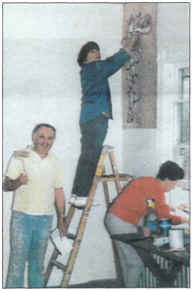
|
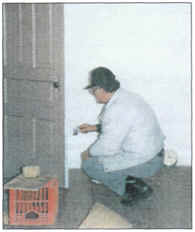
|
|
Stenciling
(before) - Joe Stein painting, Elisabeth Gebavi
trying out pre-cut stencils, Angela Stumpfoll
cleaning windows. |
Nick
Ippach and his paint brush
|
|
|
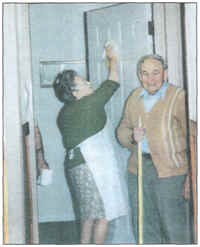 |
|
Rosi Stein stenciling while on the ladder, and
after stenciling.
Leni
Ippach was our
photographer.
|
Mr.
&
Mrs Kleiner
always ready to help
|
|
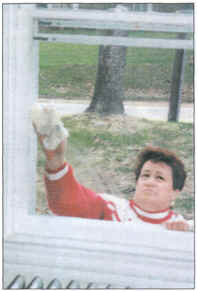
|
Erika
Reichert busy wiping dirt off the windows
|

Throughout the years I have tried to put a little extra
space with a different focus into the museum, therefore we converted
the upstairs bathroom into our
K1NDERECKE, for which I collected "Fetzapuppe"
(rag dolls), children's books,
toys, clothes, etc., and we opened this
room in 2003.
Throughout the years I have tried to put a little extra
space with a different focus into the museum, therefore we converted
the upstairs bathroom into our
K1NDERECKE, for which I collected "Fetzapuppe"
(rag dolls), children's books,
toys, clothes, etc., and we opened this room in 2003.
Hilde
Neumayer and I look forward to
your visits and enjoy talking about the treasures in
our beloved Heimatmuseum.

|

|
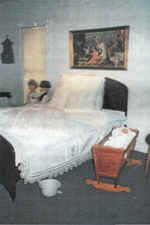
|
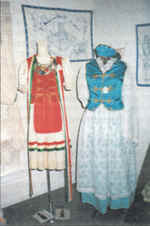
|
|
Kapelle (Chapel)
|
Inside 1st Bedroom
|
Inside 2nd Bedroom
|
|
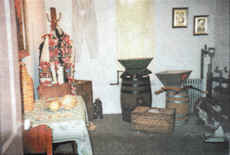 |
 |
|
Weinstube
|
Kitchen
|
|
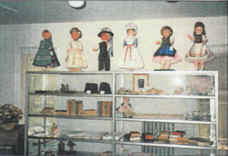 |
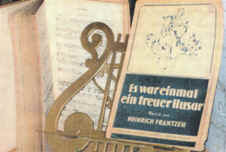 |
|
Showroom
|
Musikkammer
|
|
 |
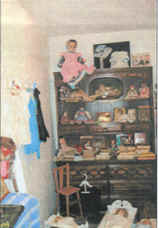
|
|
Library
|
Kinderecke
|
|

|

|



VISITING
AUTHOR-ARTICLE
JULY
2010

New
German-American Heritage Museum
Opens
in Downtown DC
Forwarded
by German American Society, Portland

The German-American Heritage
Museum of the USA highlights the history
of German immigration and migration
across the United States via various
exhibitions and events, while at the
same time introducing modern Germany to
an American audience. German Ambassador
Klaus Scharioth visited the new museum,
financed by more than $2 million in
private contributions, on March 19 in
Washington as a guest of honor during an
official opening ceremony. Senator
Richard Lugar (Republican-Indiana) and
Bernd Deichmann, president of the
German-American Heritage Foundation (GAHF),
opened the museum for business together
with Ambassador Scharioth.
Based in Hockemeyer Hall, the
former historic townhouse home of a
German immigrant, the new Heritage
Museum serves as both a local community
center as well as a national home for
German-American associations and
individuals across the country.
In a special Oral History
Research Project administered by the
museum, German- Americans - regardless
of whether they are first or fifth
generation immigrants - will be able to
record their own personal stories, which
will be used for wider educational
purposes.
"There are so many stories
of individuals and families who came to
this country to start a new life that we
would like to tell," said Rüdiger
Lentz, executive director of the museum
with decades of experience as a German
journalist and director of Deutsche
Welle programming in the United States.
The oral history research project
is funded through the European Recovery
Program, a German governmental program
to foster transatlantic relations.
"By recording, evaluating,
archiving and publishing audio-visual
testimonials from Americans of German
descent, we are following our primary
mission of preserving the rich cultural
heritage of German- Americans," the
museum states on its website.
Exhibitions
and Events Bring Heritage to Life
Permanent
and temporary exhibitions, such as on
literary influences and on German
pioneers in Alaska, will moreover
illuminate contributions both past and
present of German, as well as Austrian
and Swiss, immigrants to the United
States - from Levi Strauss (blue jeans),
to Wernher von Braun (space exploration)
to Heidi Klum (Project Runway).
Among the permanent exhibitions
is a striking historic timeline
sprawling across an entire wall of the
museum's main exhibition space tracing
German immigration to the US from 1600
to the present. Another permanent
exhibition highlights the role of German
music and choir traditions in US
history.
Rotating exhibitions will include
two separate panels highlighting the
stories of German families and of German
clubs across the country. These will be
swapped on a continuous monthly basis.
In addition to the exhibition
spaces, a modern auditorium, with
seating for up to 60 people, will serve
as a venue for lectures, multimedia
presentations and small conferences.
Educational programs designed for
students of multiple age groups will
complete the Heritage Museum's programs
and allow visitors to delve deeper into
the subject of German immigration
to
the United States.
About
the Museum
Admission to the museum is free.
A small gift shop is located near the
main entrance.
Located in the heart of DC's
booming downtown Chinatown/Penn Quarter
area, the museum is situated right
across from the Verizon Center near
several other museums, hotels,
restaurants, the Goethe-Institut and the
National Mall.
Opening hours are from 11 am to 6
pm on Tuesdays and Thursdays, from 2 pm
to 7 pm on Wednesdays, and from 12 pm to
5 pm on Saturdays and Sundays. Closed
Mondays.
http://www.gahfusa.org/gahm/gahm.html

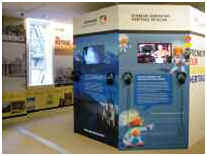 |
The
German Information
Center
USA is provided at a
kiosk
inside the museum.
|
|
The
new German-American
Heritage
Museum in
Washington.
(©
German-American Heritage
Museum
of the USA)
|
 |

|
|
|


|



VISITING
AUTHOR-ARTICLE
JULY
2010

German
Traditions
On
the Road – auf der Walz
The
Traditional Journeyman Years of the
Craftsmen
Forwarded
by German American Society, Portland

The journeyman travels of the
craftsmen have a storied tradition in
Germany that has survived until today
with a few modern adjustments. Starting
in the late Middle Ages, in the 15th
century, going "on the road"
– also known as "auf der Walz"
or Tippelei– was a training
requirement in many towns and trades for
journeymen preparing to become master
craftsmen. Only as a master was it
possible in those days to become
registered as a citizen of a town.
With ensuing industrialization in
the 18th century, the tradition of
traveling to different towns and cities
to gain experience in a trade became
less important; yet, even into the
1920s, it was still widespread in
Germany.
Today, between 600 and 800
journeymen are on the road in Germany
and abroad and approximately 10 % of
them are now women. However, travel is
no longer a mandatory requirement to
practice a trade or craft. Craftsmen who
do spend the traditional journeyman
years on the road commit to travel for
three years and one day and not to come
within a radius of 50 km of their
hometown during this time. Because the
overwhelming majority of traveling
journeymen – known as Fremder or
“strangers” – are skilled
construction workers, many people are
not aware that other crafts- and
tradesmen, such as carpenters, boat
builders, pottery makers, blacksmiths,
tailors and instrument makers, may also
go on the road to develop their skills.
The aim of their travels is
primarily to learn new trade practices
as well as to get to know foreign places
and countries. In addition to expanding
and passing on their occupational
knowledge and expertise, they also view
their travels as a means of promoting
mutual understanding and international
relations.
Customs
with Long Tradition
Craftsmen who are on the road
traditionally belong to craftsmen
associations or brotherhoods, known as
Schächte, with colorful names such as
the Rechtschaffene Fremde, the Rolandsbrüder,
or the Fremde Freiheitsschacht.
Some of these brotherhoods have
been in existence for several centuries
and have a status similar to student
organizations. Some of their symbols,
including flags and ceremonial chalices,
have been preserved since the 17th
century, and many of their customs and
rituals have remained virtually
unaltered since the Middle Ages.
Given these roots, the
brotherhoods have often also played a
political, mostly liberal and
socialdemocratic, role in the past.
Particularly in the modern age, many
brotherhoods represented and embodied
the revolutionary principles of liberty,
equality, and brotherhood. Brotherhoods,
whose members often address each other
with “dear brother,” have long
accepted members of all political
convictions, of every religion, and of
every nation.
The last remaining vestige of the
past was that women remained barred from
joining the brotherhoods for a very long
time. In the 1980s, some brotherhoods
began also accepting women. Moreover, a
growing number of journeymen are now
going on the road as free agents –
Freireisende or Wilde – who do not
join a brotherhood but who,
nevertheless, continue to observe the
traditional rules of the
craftsman’s
journey.
Meeting
the Requirements
Regardless of whether a traveling
journeyman joins a brotherhood or not,
he must meet a string of conditions:
Only those who have passed the
journeyman’s exam, are single, and
have no children or debts, may go on the
road. They are allowed to travel only on
foot or by hitch-hiking; public
transportation may be used but is
frowned upon. A journeyman may interrupt
his travels only for urgent reasons,
such as a serious illness, otherwise the
interruption is considered disreputable
and his Wanderbuch is taken away and he
must “hang up” his Kluft, the
traditional clothing worn by traveling
journeymen. Every traveling journeyman
is required to wear the Kluft in public
at all times, which simultaneously
serves to identify the traveling
journeyman as such. It generally
consists of a wide-brimmed, black,
floppy hat or cylinder, a collarless
white shirt – called a Staude – a
vest and jacket with pearl buttons,
bell-bottomed trousers, and durable
shoes. The color of the Kluft varies
according to the journeyman’s
occupation. For example, in the case of
masons and stone cutters, it is beige or
gray; in the case of woodworkers, it is
black.
In the Wanderbuch, journeymen
collect the city seals of the places
they’ve visited after calling on the
city’s mayor to present themselves as
craftsmen. When they travel abroad, they
often call on embassies and consulates
to have the
seals
stamped in their journeyman’s books.
While on the road, journeymen may
travel wherever they wish, even to
distant lands, for example, by working
for a berth on a ship to America or
Australia. When they finally return to
their hometowns after three years and
one day, they can look back on an often
austere, yet eventful, period of
unattached freedom.
http://www.gahfusa.org/gahm/gahm.html

|

|
Two
journeymen enjoy a beer
in
front of a banner for the
Rolandschacht
brotherhood.
|
|
Journeymen,
seen
in traditional
clothing
with
their walking sticks and
bundles,
pose
for a picture in front
of
the Potsdam Chamber of Crafts.
(©
picture-alliance/ZB)
|

|

|
|
|


|